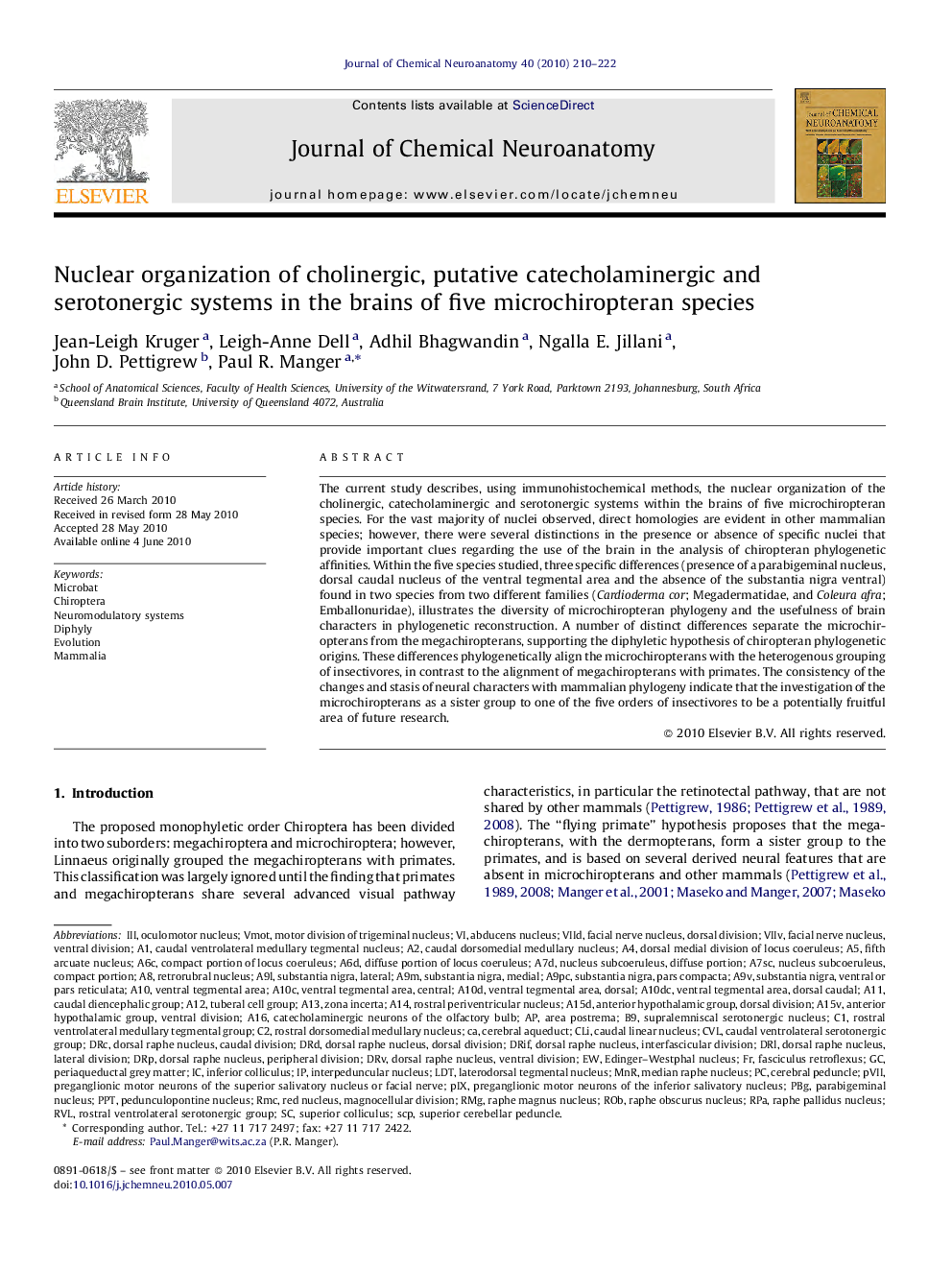| Article ID | Journal | Published Year | Pages | File Type |
|---|---|---|---|---|
| 1989047 | Journal of Chemical Neuroanatomy | 2010 | 13 Pages |
Abstract
The current study describes, using immunohistochemical methods, the nuclear organization of the cholinergic, catecholaminergic and serotonergic systems within the brains of five microchiropteran species. For the vast majority of nuclei observed, direct homologies are evident in other mammalian species; however, there were several distinctions in the presence or absence of specific nuclei that provide important clues regarding the use of the brain in the analysis of chiropteran phylogenetic affinities. Within the five species studied, three specific differences (presence of a parabigeminal nucleus, dorsal caudal nucleus of the ventral tegmental area and the absence of the substantia nigra ventral) found in two species from two different families (Cardioderma cor; Megadermatidae, and Coleura afra; Emballonuridae), illustrates the diversity of microchiropteran phylogeny and the usefulness of brain characters in phylogenetic reconstruction. A number of distinct differences separate the microchiropterans from the megachiropterans, supporting the diphyletic hypothesis of chiropteran phylogenetic origins. These differences phylogenetically align the microchiropterans with the heterogenous grouping of insectivores, in contrast to the alignment of megachiropterans with primates. The consistency of the changes and stasis of neural characters with mammalian phylogeny indicate that the investigation of the microchiropterans as a sister group to one of the five orders of insectivores to be a potentially fruitful area of future research.
Keywords
DRCA10cA9vA9pcA9mA9lA7scA7dA6dA10dA16RVLA11DRLA14PIXA10VIIdpVIIcaudal ventrolateral serotonergic grouprostral dorsomedial medullary nucleussupralemniscal serotonergic nucleuscatecholaminergic neurons of the olfactory bulbnucleus subcoeruleus, compact portionnucleus subcoeruleus, diffuse portioncaudal dorsomedial medullary nucleusRMGVmotsubstantia nigra, medialsubstantia nigra, lateralVIIvA15vA15dA10dcPPTCVLDRPSCPIIIA12DRDCLiDRVRMCFasciculus retroflexusRPAPBGLDTA13MnRsuperior cerebellar peduncleabducens nucleussubstantia nigra, pars compactaChiropteraSuperior colliculuscerebral pedunclearea postremaDRifRObEvolutiondiffuse portion of locus coeruleuscerebral aqueductPeriaqueductal grey matterventral tegmental area, centralventral tegmental area, dorsal caudalventral tegmental area, dorsalzona incertaventral tegmental areaEdinger–Westphal nucleusinterpeduncular nucleusoculomotor nucleusParabigeminal nucleusPedunculopontine nucleusretrorubral nucleusCaudal linear nucleusmedian raphe nucleusraphe pallidus nucleusraphe magnus nucleuscaudal ventrolateral medullary tegmental nucleusraphe obscurus nucleusrostral periventricular nucleuslaterodorsal tegmental nucleusMammaliafifth arcuate nucleusInferior colliculuscaudal diencephalic grouprostral ventrolateral medullary tegmental grouptuberal cell groupanterior hypothalamic group, ventral divisionanterior hypothalamic group, dorsal division
Related Topics
Life Sciences
Biochemistry, Genetics and Molecular Biology
Biochemistry
Authors
Jean-Leigh Kruger, Leigh-Anne Dell, Adhil Bhagwandin, Ngalla E. Jillani, John D. Pettigrew, Paul R. Manger,
